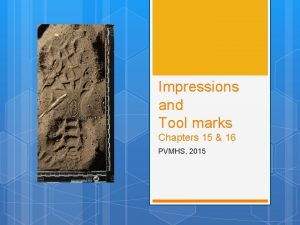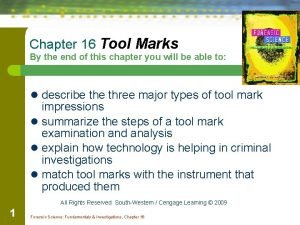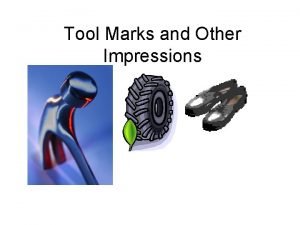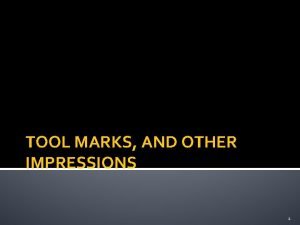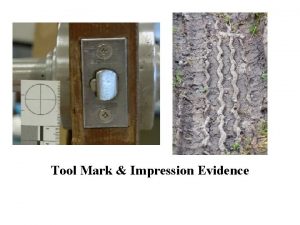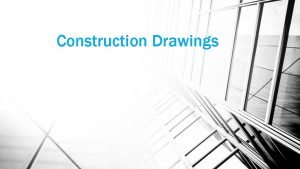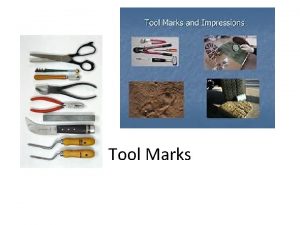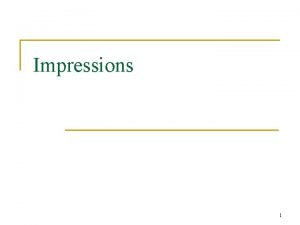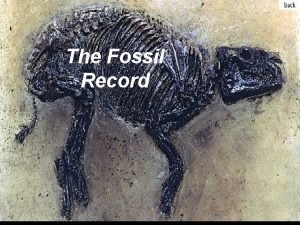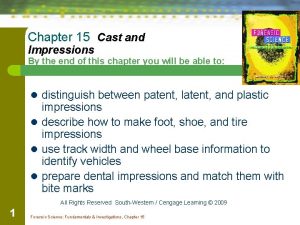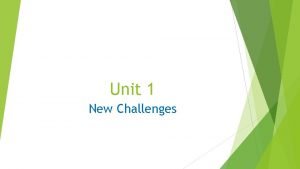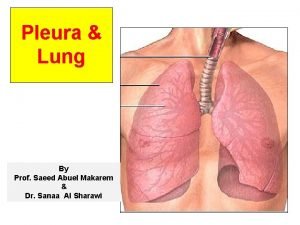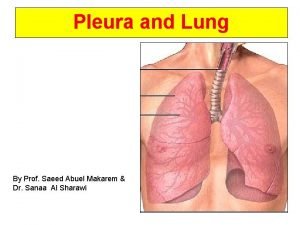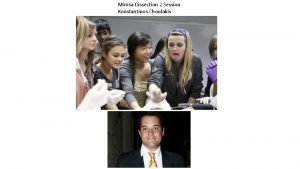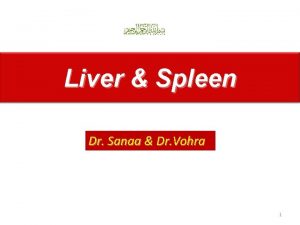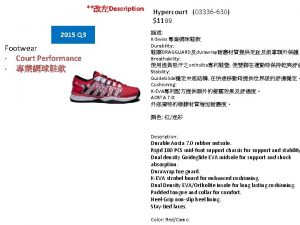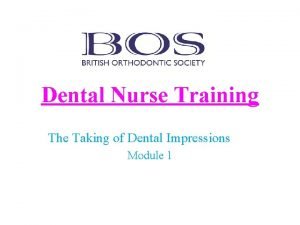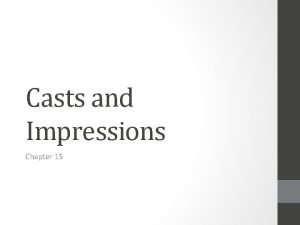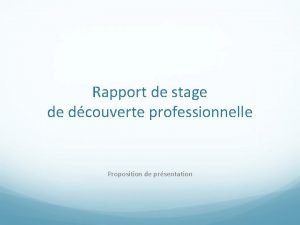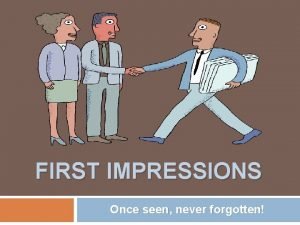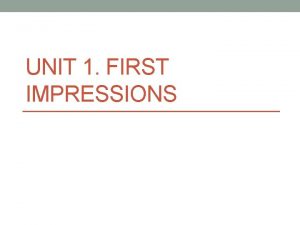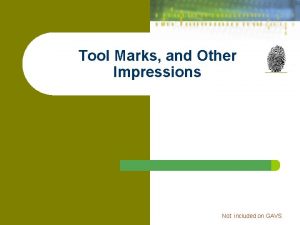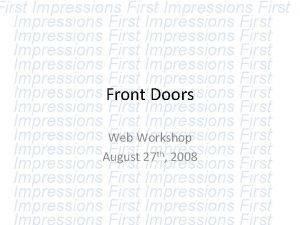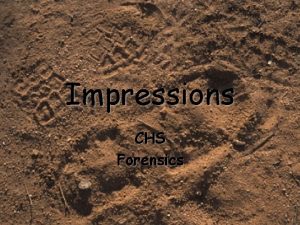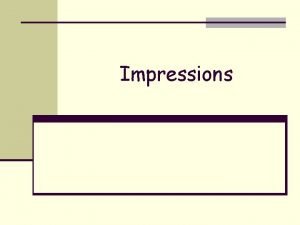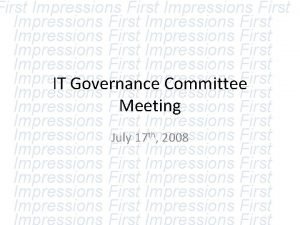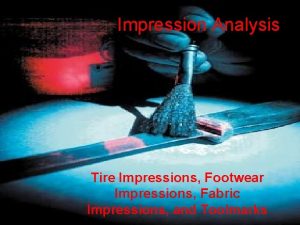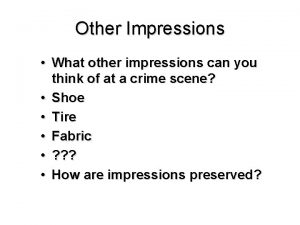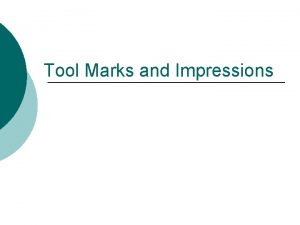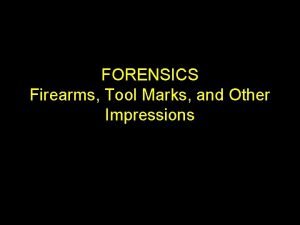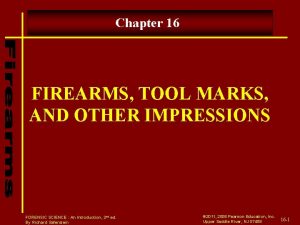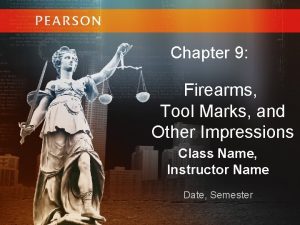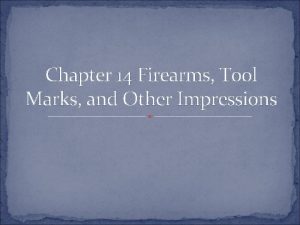Tool Marks and Other Impressions Not included on








































- Slides: 40

Tool Marks, and Other Impressions Not included on GAVS

SFS 4 Students will evaluate the role of ballistics, tool marks and evidence of arson in forensic investigation. c. Recognize the forensic significance of tool marks, footwear and tire impressions in an investigation. SFS 1. Students will recognize and classify various types of evidence in relation to the definition and scope of Forensic Science. 2 b. Distinguish and categorize physical and trace evidence (e. g. ballistics, drugs, fibers, fingerprints, glass, hair, metal, lip prints, soil, and toxins).

Learning Targets: I can o o 3 Distinguish between patent, latent, and plastic impressions Describe how to make foot, shoe, and tire impressions Use track width and wheel base information to identify vehicles Prepare dental impressions and match them with bite marks

Introduction People, vehicles, and objects leave evidence of their presence at an accident or crime scene. o o o 4 Patent impressions are two-dimensional Latent impressions are hidden to the eye Plastic impressions are three-dimensional

Tool Marks (part of GAVS 15) Any impression, scratch, or abrasion made when contact occurs between a tool and an object. It is the presence of any minute imperfections on a tool that imparts individuality to that tool. The shape and pattern of such imperfections are further modified by damage and wear during the life of the tool. 5

Tool Marks

Tool Marks The comparison microscope is used to compare crime-scene tool marks with test impressions made with the suspect tool. Observation of striations on tools to compare to marks made at the crime scene can help link a particular tool to a crime scene and possibly a suspect. When practical, the entire object, or the part of the object bearing the tool mark, should be submitted to the crime laboratory for examination.

Tool Marks Under no circumstances must the crime scene investigator attempt to fit the suspect tool into the tool mark. Ø Any contact between the tool and the marked surface may alter the mark and will, at the very least, raise serious questions about the integrity of the evidence. Ø Instead, a clay or putty casting should be used to mold a pattern of the weapon.

Tool Mark Casting 9

Tool Marks Most common types of tool marks include: Abrasion marks – made when one surface slides across another essentially scratching the surface. Cutting marks Indentation marks – made when a tool is pressed against a softer surface resulting in an impression of the harder tool in the softer material.

Other Impressions of other kinds, such as shoe, tire, or fabric impressions, may be important evidence. Before any impression is moved or otherwise handled, it must be photographed (with a scale included) to show all of the observable details of the impression. Tire and shoe prints can be preserved by casting them in plaster. Fabric impressions can be made in a variety of ways.

Other Impressions If the impression is on a readily recoverable item, such as glass, paper, or floor tile, the evidence is transported intact to the laboratory. If the surface cannot be submitted to the laboratory, the investigator may be able to preserve the print in a manner similar to lifting a fingerprint.

Other Impressions When shoe and tire marks are impressed into soft earth at a crime scene, their preservation is best accomplished by photography and casting. In areas where a bloody footwear impression is very faint, or where the subject has tracked through blood leaving a trail of bloody impressions, chemical enhancement can visualize latent or nearly invisible blood impressions.

Points of Comparison A sufficient number of points of comparison or the uniqueness of such points will support a finding that both the questioned and test impressions originated from one, and only one, source.

Points of Comparison New computer software and web sites may be able to assist in making shoe print and tire impression comparisons. Also, bite mark impressions on skin and foodstuffs have proven to be important evidence in a number of homicide and rape cases.

Shoe Impressions o o 16 Shoeprint size indicates the foot size The depth of a foot or shoe impression indicates a person’s weight The type of shoe can tell something of the person’s job or personality Databases contain the names of specific manufactures and tread designs

Casting Shoe Impressions 17

Comparing Shoe Size and Height 18

Shoe Wear Patterns Factors that personalize a person’s footwear: o Body weight o The way a person walks • Weight distribution • Direction of toes (straight, pointing out or in) o o 19 The surface on which the person walks Unique holes, cuts, and debris embedded in the tread

Shoe Wear Patterns 20

Collection of Shoe Impression Evidence Why would the following steps be important? 1. Take photos as soon as possible 2. Take multiple photos of the impression from at least two different orientations 3. Place an identifying label and a ruler in position with the impression for the photo 4. Use oblique lighting when possible 21

Lifting Latent Impressions Different methods to make latent prints visible: o o o 22 Luminol makes bloody footprints visible for photography Dusting the latent print reveals an impression for lifting or photography Electrostatic lifting and gel lifting (image below) techniques can capture hidden impressions

Electrostatic Dusting and Lifting o o o 23 Electrostatic dusting reveals dust left with each step and creates an impression Electrostatic charges can lift impressions from paper wood surfaces carpeting linoleum asphalt concrete Gel lifters also recover latent impressions

Latent Shoe Prints 24

Shoe Print Lab http: //corningelp. weebly. com/s hoe-impression-lab. html 25

Tire Treads and Impressions o o 26 Tire treads—ridges and grooves channel water away and provide traction Patent tread patterns—impressions made after tire runs through a fluid material Latent tread patterns—impressions from tire oils used to keep tires soft and pliable Plastic tread patterns—three dimensional impressions left in soft surfaces

Tire Treads and Impressions o o o 27 Tread patterns can indicate the type of vehicle that left the mark Link a suspect or victim to a crime scene Reveal events that took place at the scene

28

Anatomy of a Tire 29

Recording Tread Impressions o o o 30 Count ridges and grooves across the tire width Note unique characteristics—wear or pebbles embedded in the grooves Create a print of the suspect’s tire impressions through one revolution Compare impressions from the crime scene and suspect’s tire Identifying tread patterns may not be enough to link a suspect with a crime scene

Tire track casting 31

Identifying a Vehicle Track widths— From center of tire to center of tire Wheelbase length— From center of front axle to center of rear axle 32

Identifying a Vehicle o Turning diameter Databases can be checked to find the vehicle with these specifications 33

Accident Reconstruction o o o 34 Drivers may not recall the exact series of events before, during, and after an accident People, vehicles, and objects, however, can leave evidence of their actions at the scene of an accident Debris patterns and tire marks can be clues to speed, direction, and vehicle identification

Accident Reconstruction There are three basic types of tire marks: o Skid marks—clues to the distance traveled after brakes are applied and the vehicle’s speed Yaw marks—shows a sideways skid o Tire scrub—determines the area of impact o How are each of these formed? 35

Dental Impressions o o 36 Occasionally a perpetrator will leave behind a bite mark—considered individual evidence Note differences in the size of teeth and jaws, position, fillings, crowns, caps, breakage, and crowding

Development of Teeth 37

Dental Patterns in Forensics o o 38 The investigation consists of recognizing, documenting, collecting, and analyzing evidence What are the two basic ways dental patterns can be used in forensic investigations? There are 76 points of comparison when comparing a suspect’s dental patterns with bite marks left at a crime scene What is the common method used to reveal whethere is a match?

Bite mark 39

. . . . Summary o o 40 Impression evidence—whether patent, latent, or plastic—will be considered class evidence unless it has individualizing features. Debris patterns and tire marks can be clues to speed, direction, and vehicle identification. Differences in dental patterns can connect a person to a crime scene. Documentation (including early photos) is extremely important in an investigation.
 Trooper
Trooper Abrasion tool marks
Abrasion tool marks Tool impressions
Tool impressions First impressions four marks
First impressions four marks When we use exclamation mark
When we use exclamation mark Patent impressions
Patent impressions Rifled barrel
Rifled barrel Whats not included in gdp
Whats not included in gdp In the alphabet of lines an area not included
In the alphabet of lines an area not included What are tool marks
What are tool marks Why are footprints easier to cast than tire tracks
Why are footprints easier to cast than tire tracks Not genuine, not true, not valid
Not genuine, not true, not valid Chapter 15 firearms toolmarks and impressions
Chapter 15 firearms toolmarks and impressions Evidence of evolution of remnants and impressions *
Evidence of evolution of remnants and impressions * Some factors that personalize our footwear include:
Some factors that personalize our footwear include: Self initiated other repair
Self initiated other repair Potter's wheel data cleaning tool
Potter's wheel data cleaning tool Impression vocabulary
Impression vocabulary Examples of dominant impression sentences
Examples of dominant impression sentences Ma vision du métier observé
Ma vision du métier observé Back view of lungs in body
Back view of lungs in body Mediastinal surface
Mediastinal surface T4 cross section
T4 cross section Nerve supply of spleen
Nerve supply of spleen Liver impressions
Liver impressions Class characteristics of footwear impressions
Class characteristics of footwear impressions Dental impression taking course
Dental impression taking course Which creates shadows for photographing impression evidence
Which creates shadows for photographing impression evidence Mes impressions sur le stage exemple
Mes impressions sur le stage exemple Once met never forgotten
Once met never forgotten Welcome to service
Welcome to service Unit 1 first impressions
Unit 1 first impressions True or false
True or false Turning diameter definition forensics
Turning diameter definition forensics Literacy narrative essay examples
Literacy narrative essay examples Sufficient recurve
Sufficient recurve Are impressions left by friction ridge skin on a surface
Are impressions left by friction ridge skin on a surface 1st impressions clothing
1st impressions clothing Describe where grendel lives and the nature of his origins
Describe where grendel lives and the nature of his origins What are your first impressions of beowulf
What are your first impressions of beowulf Examples of dominant impressions
Examples of dominant impressions
